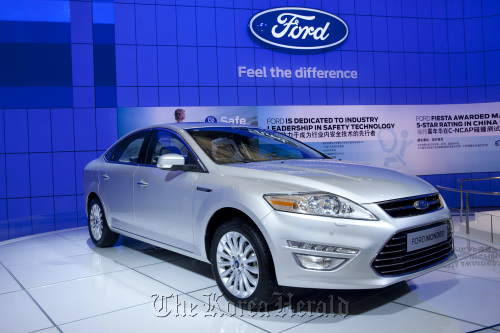DETROIT (AFP) ― With its turnaround in North America essentially finished, Ford Motor Co. is looking to the next act in its comeback by building its business in Asia’s emerging markets.
Ford plans to grow global sales by 50 percent over the next four years with a strong push into markets such as China and India, chief executive officer Alan Mulally said last week.
Ford plans to grow global sales by 50 percent over the next four years with a strong push into markets such as China and India, chief executive officer Alan Mulally said last week.

“We are rapidly making the transition from fixing the fundamentals of our business to delivering profitable growth in all of our operations,” Mulally said in the company’s recent annual report.
“To do this, we are investing in an unprecedented amount of new products and technology worldwide.”
Ford’s plans to target growing demand in emerging markets makes sense, said Jesse Toprak, an analyst with TrueCar.com.
“Eighty percent of all growth will occur outside of North America. So it’s smart to target growth in these markets,” he told AFP.
Ford, which was the only major U.S. automaker to survive the 2008 downturn without resorting to a government bailout and bankruptcy, has also profited from the troubles at General Motors and Chrysler.
Ford’s rating was downgraded to junk status after it essentially mortgaged all its assets to fund a massive restructuring, but the number two U.S. automaker has been able to revitalize its lineup and business practices much more rapidly than its Detroit rivals.
But Ford will face stiff competition from Volkswagen AG, General Motors and Toyota, which already have large pieces of the Asian market, especially in China.
Ford remains a minor player in China ― as a group it has less than three percent of the passenger vehicle market in the world’s second-biggest economy and about one percent of the light commercial vehicle market.
But growth has been strong ― Ford Motor China and its joint ventures sold 582,467 vehicles last year, up 40 percent.
“Ford’s plan to expand (global) sales by 50 percent through 2015 is doable, in our view, but won’t be easy,” Standard & Poors analyst Efraim Levy said in a recent note.
“The target, however, will be supported, in our view by rising demand in emerging markets such as the BRIC (Brazil, Russia, India and China) countries, and an increase in Ford vehicle offerings, especially smaller-sized ones, in these regions.”
Meanwhile, Ford’s financial strength continues to grow. The automaker doubled its annual profits to $6.6 billion in 2010 and followed up with a $2.6 billion profit in the first quarter of 2011 ― the company’s largest quarterly profit since 1998.
Chief financial officer Lewis Booth said the stream of strong earnings put Ford in a position to pay off outstanding debts, and expressed confidence that it would return to an investment grade rating in the next 12 months.
To get that rating, Ford has to negotiate a new contract with the powerful United Auto Workers union. “We’re expecting to get through the negotiations with the UAW with a good tone,” Booth said on a conference call last week.
Ford has also shown that it has finally figured out how to make a profit on small cars, said Walter McManus, economist for the University of Michigan’s Transportation Research Institute.
“Automakers can profit from investing in fuel-efficient vehicles,” he said, explaining that as gas prices rise, consumers are willing to pay more for fuel efficient cars.
Ford’s F-150 pickup truck remains the most popular vehicle sold in the United States, but the Ford lineup has been extended with the addition of European-designed vehicles such as the Focus and Fiesta.
“We sold more small cars in May than we have in years,” noted Jim Farley, Ford’s vice president of global sales, services and marketing, reversing the company’s long-time dependence on pickup trucks and sport utility vehicles.
Ford will expand its fuel-efficient lineup next year when it adds the hybrid and plug-in electric versions of the C-Max to its model line.
Overall small cars will account for 55 percent of the company’s sales by 2015, Mulally told analysts.
With the sale of its luxury brands Volvo, Land Rover and Jaguar, the major weakness in Ford’s model line is the lack of a credible luxury car, which industry observers say is key to growth in places such as China.
But Ford is moving to fix that problem, said Alan Baum, an independent analyst based in Detroit.
“Lincoln is missing products in some key segments and they are working towards filling those holes,” Baum told AFP.









![[Kim Seong-kon] Democracy and the future of South Korea](http://res.heraldm.com/phpwas/restmb_idxmake.php?idx=644&simg=/content/image/2024/04/16/20240416050802_0.jpg&u=)







![[KH Explains] Hyundai's full hybrid edge to pay off amid slow transition to pure EVs](http://res.heraldm.com/phpwas/restmb_idxmake.php?idx=652&simg=/content/image/2024/04/18/20240418050645_0.jpg&u=20240418181020)

![[Today’s K-pop] Zico drops snippet of collaboration with Jennie](http://res.heraldm.com/phpwas/restmb_idxmake.php?idx=642&simg=/content/image/2024/04/18/20240418050702_0.jpg&u=)